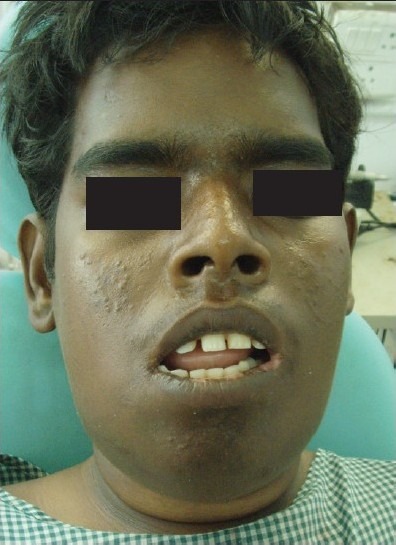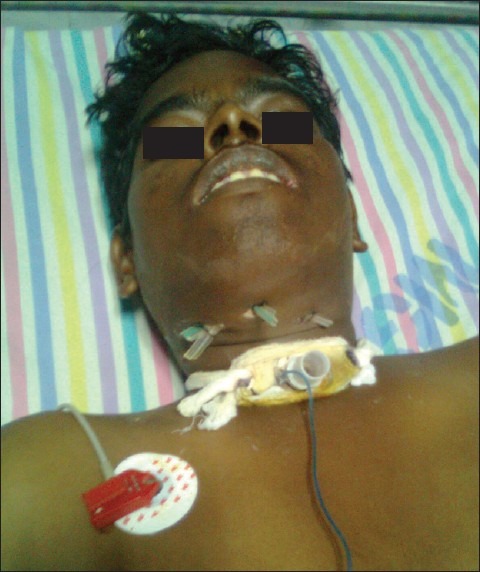Abstract
Ludwig's angina is a form of severe diffuse cellulitis that presents an acute onset and spreads rapidly, bilaterally affecting the submandibular, sublingual and submental spaces resulting in a state of emergency. Early diagnosis and immediate treatment planning could be a life-saving procedure. Here we report a case of wide spread odontogenic infection extending to the neck with elevation of the floor of the mouth obstructing the airway which resulted in breathlessness and stridor for which the patient was directed to maintain his airway by elective tracheostomy and subsequent drainage of the potentially involved spaces. Late stages of the disease should be addressed immediately and given special importance towards the maintenance of airway followed by surgical decompression under antibiotic coverage. The appropriate use of parenteral antibiotics, airway protection techniques, and formal surgical drainage of the infection remains the standard protocol of treatment in advanced cases of Ludwig's angina.
Keywords: Ludwig's angina, odontogenic infection, surgical decompression, tracheostomy
INTRODUCTION
Ludwig's angina was coined after the German physician, Wilhelm Friedrich von Ludwig who first described this condition in 1836 as a rapidly and frequently fatal progressive gangrenous cellulitis and edema of the soft tissues of the neck and floor of the mouth.[1] With progressive swelling of the soft tissues and elevation and posterior displacement of the tongue, the most life-threatening complication of Ludwig's angina is airway obstruction. Prior to the development of antibiotics, mortality for Ludwig's angina exceeded 50%.[2] As a result of antibiotic therapy, along with improved imaging modalities and surgical techniques, mortality currently averages approximately 8%.[2,3]
In Ludwig's angina, the submandibular space is the primary site of infection.[4] This space is subdivided by the mylohyoid muscle into the sublingual space superiorly and the submaxillary space inferiorly. The majority of cases of Ludwig's angina are odontogenic in etiology, primarily resulting from infections of the second and third molars. The roots of these teeth penetrate the mylohyoid ridge such that any abscess, or dental infection, has direct access to the submaxillary space. Once infection develops, it spreads contiguously to the sublingual space. Infection can also spread contiguously to involve the pharyngomaxillary and retropharyngeal spaces, thereby encircling the airway.
Other causes include peritonsillar or parapharangeal abscesses, mandibular fractures, oral lacerations/piercing or submandibular sialadenitis, and oral malignancy.[5] Predisposing factors include dental caries, recent dental treatment, systemic illness such as diabetes mellitus, malnutrition, alcoholism, compromised immune system such as AIDS and organ transplantation.[6–9] Without a treatment, it is frequently fatal from the risk of asphyxia with a mortality rate of 50%. The aggressive surgical intervention, the antibiotic introduction, and the improvement of dental care have determined a significant reduction of the mortality rate to less than 10%.[10]
CASE REPORT
A 25-year-old gentleman reported to the Department of Oral and Maxillofacial Surgery with a chief complaint of inability to open the mouth, pain, and swelling in relation to the lower jaw and neck since a day. On physical examination, he had respiratory distress and was toxic in appearance and his vital signs were monitored immediately. His temperature was 101.8°F with a pulse rate of 106 beats per minute, blood pressure of 140/90 mmHg, and a respiratory rate of 25 breaths per minute. Mouth opening was limited to 1.5 cm (interincisal distance) and revealed grossly decayed lower right second molar tooth with drainage of pus. Extra-oral swelling was indurated, nonfluctuant with bilateral involvement of the submandibular and sublingual glands [Figure 1]. An immediate diagnosis of Ludwig's angina was made, and the patient was posted for surgical decompression under general anesthesia. However, elective tracheostomy was planned for airway maintenance with the help of an otolaryngologist. The blood report was normal except for raise in ESR, eosinophilia. Elective tracheostomy was done under local anesthesia, airway secured and general anesthesia was provided. Separate stab incisions was made in relation to the submandibular space bilaterally and submental space. A sinus forceps was introduced to open up the tissue spaces and pus was drained. The wound was irrigated with normal saline, and a separate tube drain was placed and secured to the skin with silk sutures [Figure 2]. Intravenous administration of cefotaxime 1 g Bd, gentamycin 80 mg Bd, metrogyl 500 mg, Tid were given for 5 days with a tapering dose of decadran 8–4 mg Bd for first two postoperative days. Postoperative irrigation was done through the drain which was removed after 36 h along with the infected tooth. Tracheostomy tube care was taken in the postoperative period, and the skin was strapped on the fifth postoperative day after the removal of the tracheostomy tube. Patient recovery was satisfactory.
Figure 1.

Preoperative appearance with bilateral involvement of the submandibular, sublingual, and the submental spaces showing brawny induration of the swelling
Figure 2.

Postoperative view showing the tube drains and tracheostomy tube in place
DISCUSSION
Ludwig's angina and deep neck infections are dangerous because of their normal tendency to cause edema, distortion, and obstruction of airway and may arise as a consequence of airway management mishaps. In the early stages of the disease, patients may be managed with observation and intravenous antibiotics. Advanced infections require the airway to be secured with surgical drainage. This is complicated by pain, trismus, airway edema, and tongue displacement creating a compromised airway.
β-hemolytic streptococcus associated with anaerobic germs such as peptostreptococcus and pigmented bacteroides have been described as causative agents. Streptococcus viridans (40.9%), Staphylococcus aureus (27.3%), and Staphylococcus epidermis (22.7%) were isolated from deep neck infections. Intravenous penicillin G, clindamycin or metronidazole are the antibiotics recommended for use prior to obtaining culture and antibiogram results. Some authors also recommend the association of gentamycin.[11,12] Recent case reports advocated the use of intravenous steroids which potentially avoided the need for airway management.[1,4]
If patients present with swelling, pain, elevation of the tongue, malaise, fever, neck swelling, and dysphagia, the submandibular area can be indurated, sometimes with palpable crepitus. Inability to swallow saliva and stridor raise concern because of imminent airway compromise. The most feared complication is airway obstruction due to elevation and posterior displacement of the tongue.[3] To reduce the risk of spread of infection, needle drainage can be performed.[13]
Airway compromise is always synonymous with the term Ludwig's angina, and it is the leading cause of death. Therefore, airway management is the primary therapeutic concern.[3] The stage of the disease and comorbid conditions at the time of presentation, physician experience, available resources, and personnel are all crucial factors in the decision making.[14] Immediate involvement of an anesthetist and an otolaryngology team is crucial.[15] Blind nasotracheal intubation should not be attempted in patients with Ludwig's angina given the potential for bleeding and abscess rupture.[4,14,15] Flexible nasotracheal intubation requires skill and experience, if not feasible, cricothyrotomy and tracheostomy under local anesthesia are occasionally performed in the emergency department in those with advanced stages of the disease.[16] Elective awake tracheostomy is a safer and more logical method of airway management in patients with a fully developed Ludwig's angina.[17]
Tracheostomy using local anesthesia has been considered the “gold standard” of airway management in patients with deep neck infections, but it may be difficult or impossible in advanced cases of infection because of the position needed for tracheostomy or because of anatomical distortion of the anterior neck.[18–20]
Footnotes
Source of Support: Nil.
Conflict of Interest: None declared.
REFERENCES
- 1.Saifeldeen K, Evans R. Ludwig's angina. Emerg Med J. 2004;21:242–3. doi: 10.1136/emj.2003.012336. [DOI] [PMC free article] [PubMed] [Google Scholar]
- 2.Bansal A, Miskoff J, Lis RJ. Otolaryngologic critical care. Crit Care Clin. 2003;19:55–72. doi: 10.1016/s0749-0704(02)00062-3. [DOI] [PubMed] [Google Scholar]
- 3.Moreland LW, Corey J, McKenzie R. Ludwig's angina. Report of a case and review of the literature. Arch Intern Med. 1988;148:461–6. doi: 10.1001/archinte.148.2.461. [DOI] [PubMed] [Google Scholar]
- 4.Spitalnic SJ, Sucov A. Ludwig's angina: Case report and review. J Emerg Med. 1995;13:499–503. doi: 10.1016/0736-4679(95)80007-7. [DOI] [PubMed] [Google Scholar]
- 5.Fischmann GE, Graham BS. Ludwig's angina resulting from the infection of an oral malignancy. J Oral Maxillofac Surg. 1985;43:795–6. doi: 10.1016/0278-2391(85)90337-4. [DOI] [PubMed] [Google Scholar]
- 6.Owens BM, Schuman NJ. Ludwig's angina. Gen Dent. 1994;42:84–7. [PubMed] [Google Scholar]
- 7.Owens BM, Schuman NJ. Ludwig's angina: Historical perspective. J Tenn Dent Assoc. 1993;73:19–21. [PubMed] [Google Scholar]
- 8.LeJeune HB, Amedee RG. A review of odontogenic infections. J La State Med Soc. 1994;146:239–41. [PubMed] [Google Scholar]
- 9.Finch RG, Snider GE, Jr, Sprinkle PM. Ludwig's angina. JAMA. 1980;243:1171–3. [PubMed] [Google Scholar]
- 10.Britt JC, Josephson GD, Gross CW. Ludwig's angina in the pediatric population: Report of a case and review of the literature. Int J Pediatr Otorhinolaryngol. 2000;52:79–87. doi: 10.1016/s0165-5876(99)00295-5. [DOI] [PubMed] [Google Scholar]
- 11.Har-El G, Aroesty JH, Shaha A, Lucente FE. Changing trends in deep neck abscess. A retrospective study of 110 patients. Oral Surg Oral Med Oral Pathol. 1994;77:446–50. doi: 10.1016/0030-4220(94)90221-6. [DOI] [PubMed] [Google Scholar]
- 12.Kurien M, Mathew J, Job A, Zachariah N. Ludwig's angina. Clin Otolaryngol Allied Sci. 1997;22:263–5. doi: 10.1046/j.1365-2273.1997.00014.x. [DOI] [PubMed] [Google Scholar]
- 13.Bross-Soriano D, Arrieta_Gómez JR, Prado-Calleros H, Schimelmitz-ldi J, Jorba-Basave S. Management of Ludwig's angina with small neck incisions: 18 years experience. Otolaryngol Head Neck Surg. 2004;130:712–7. doi: 10.1016/j.otohns.2003.09.036. [DOI] [PubMed] [Google Scholar]
- 14.Shockley WW. Ludwig's angina: A review of current airway management. Arch Otolaryngol Head Neck Surg. 1999;125:600. doi: 10.1001/archotol.125.5.600. [DOI] [PubMed] [Google Scholar]
- 15.Marple BF. Ludwig's angina: A review of current airway management. Arch Otolaryngol Head Neck Surg. 1999;125:596–9. doi: 10.1001/archotol.125.5.596. [DOI] [PubMed] [Google Scholar]
- 16.Neff SP, Merry AF, Anderson B. Airway management in Ludwig's angina. Anaesth Intensive Care. 1999;27:659–61. doi: 10.1177/0310057X9902700323. [DOI] [PubMed] [Google Scholar]
- 17.Parhiscar A, Har-El G. Deep neck abscess: A retrospective study of 210 cases. Ann Otol Rhinol Laryngol. 2001;110:1051–4. doi: 10.1177/000348940111001111. [DOI] [PubMed] [Google Scholar]
- 18.Irani BS, Martin-Hirsch D, Lannigan F. Infection of the neck spaces: A present day complication. J Laryngol Otol. 1992;106:455–8. doi: 10.1017/s0022215100119826. [DOI] [PubMed] [Google Scholar]
- 19.Sethi DS, Stanley RE. Deep neck abscesses – changing trends. J Laryngol Otol. 1994;108:138–43. doi: 10.1017/s0022215100126106. [DOI] [PubMed] [Google Scholar]
- 20.Busch RF, Shah D. Ludwig's angina: Improved treatment. Otolaryngol Head Neck Surg. 1997;117:S172–5. doi: 10.1016/S0194-59989770093-7. [DOI] [PubMed] [Google Scholar]


